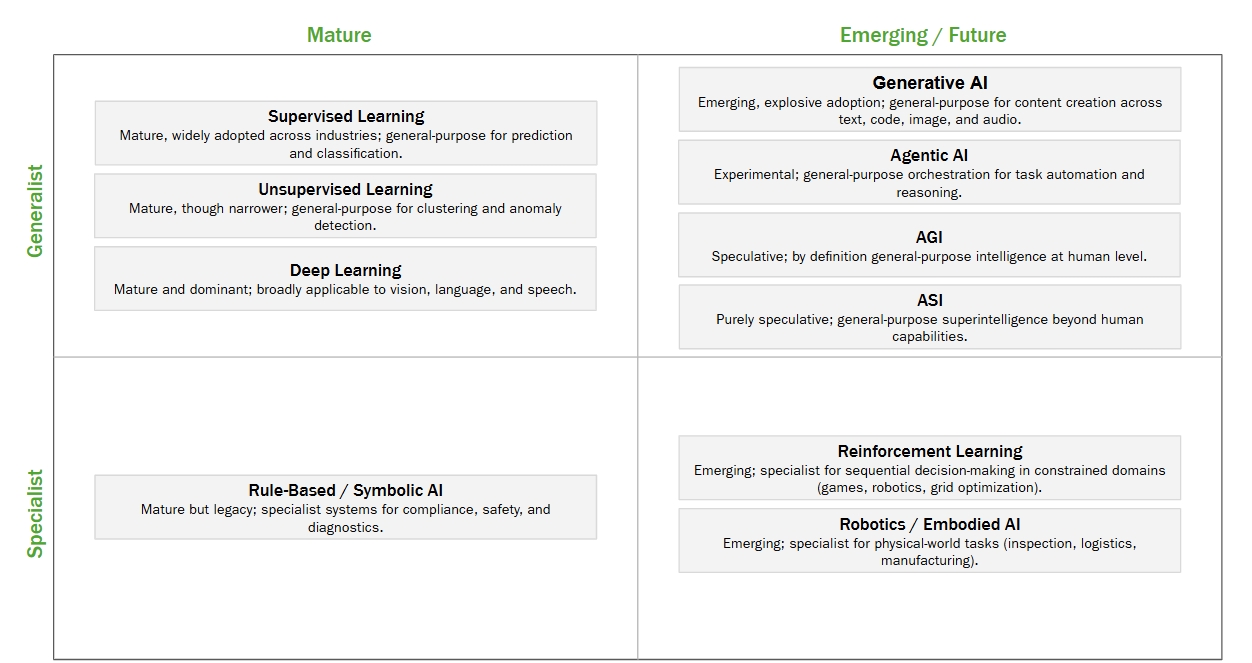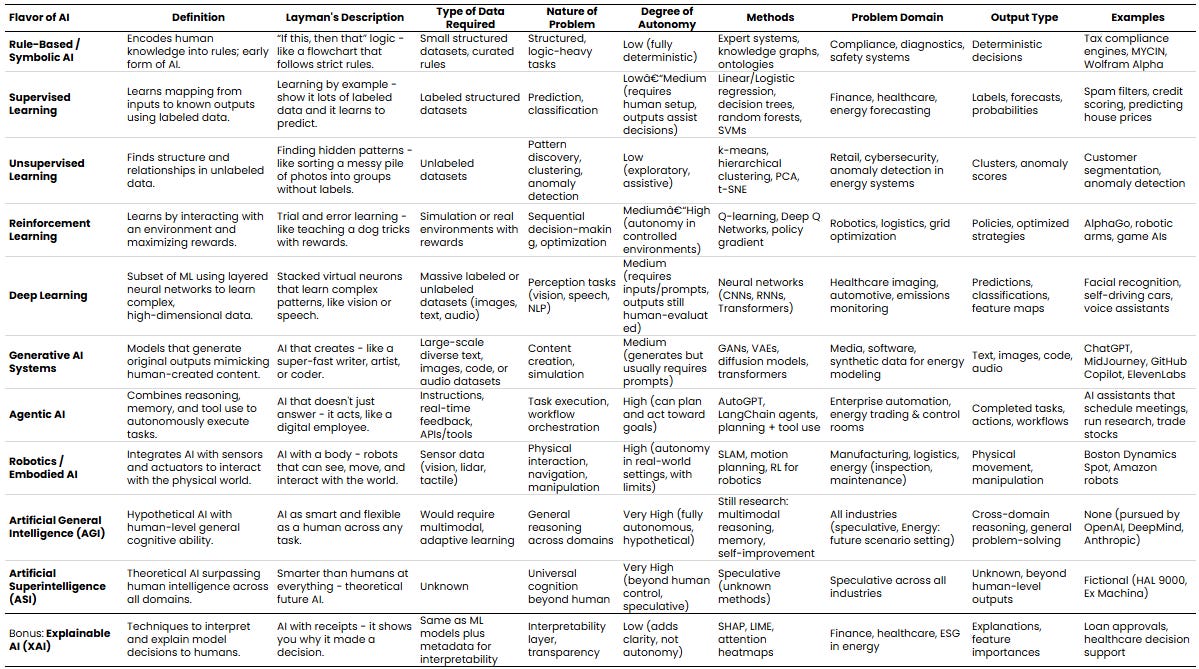AI is everywhere. It seems like everyone is “deploying and adopting AI” and that everyone has an “AI strategy”. But what does this mean? Dig deeper and you discover that AI is an umbrella term for many things and more specific language is required to truly understand what is being adopted, developed and deployed.
What follows is my working understanding of AI and the “flavors” that fall under the umbrella.
Note: Comments and suggestions to improve and refine these descriptions are welcome and appreciated.
What is AI?
A Definition of AI
Artificial Intelligence (AI) is a spectrum of technologies—from rule-based systems to machine learning and robotics—that aim to mimic, extend, or surpass human intelligence.
The field of computer science focused on building these systems spans five broad groupings, each with distinct roles and capabilities.
Five AI Groupings
Symbolic / Rule-Based AI — encodes human expertise into explicit rules and logic to automate decisions in structured domains.
Machine Learning & Predictive AI — learns patterns from data to predict outcomes, classify inputs, or optimize decisions, ranging from regression and clustering to reinforcement learning and deep neural networks.
Generative AI — creates new content such as text, images, audio, or code by learning patterns from vast datasets.
Agentic / Autonomous AI — goes beyond prediction and generation to plan, reason, and take autonomous actions toward goals, often by combining generative and predictive techniques with external tools.
Embodied & Future AI — extends intelligence into the physical world through robotics, and into speculative domains like Artificial General Intelligence (AGI) and Artificial Superintelligence (ASI).
AI Groupings, Descriptions & Flavors
Within the five groups sit 10 “flavors”. The flavors are distinguishable based on:
Data type (structured vs unstructured, labeled vs unlabeled, symbolic vs experiential).
Problem type (predict, discover, generate, act, interact).
Autonomy (fixed rules → predictive → creative → autonomous → embodied).
Outputs (forecasts, clusters, content, actions, physical changes).
Maturity (mature, emerging, experimental, speculative)
Symbolic / Rule-Based AI
Description: The earliest wave of AI — systems built on explicit human-written rules and logic. Great for well-defined problems, brittle for messy real-world data. Distinct for its hand-coded logic
Rule-Based / Symbolic AI (GOFAI): Expert systems using “if/then” rules; encodes human expertise into decision logic.
Machine Learning & Predictive AI
Description: The dominant wave of AI today — systems that learn patterns from data to predict, classify, and optimize outcomes. Distinct for its pattern recognition from data.
Supervised Learning: Learns from labeled examples (e.g., predicting house prices, spam detection).
Unsupervised Learning: Finds hidden patterns in unlabeled data (e.g., clustering customers, anomaly detection).
Reinforcement Learning (RL): Learns by trial and error with rewards (e.g., AlphaGo, grid optimization).
Deep Learning: Multi-layer neural networks that handle complex, high-dimensional data (vision, speech, text).
Bonus: Explainable AI (XAI)
Description: Tools and techniques to make ML/Deep Learning decisions transparent and interpretable.
Explainable AI (XAI) is a cross-cutting field focused on making decisions from complex models, particularly deep learning, transparent and interpretable. It is not a type of learning itself but a set of tools and techniques applied to other flavors.
Generative AI
Description: The creative wave of AI — models that produce new text, images, audio, or code based on patterns in training data. Distinct for its content creation ability.
Generative AI Systems: Uses GANs, diffusion models, and transformers to create content (ChatGPT, Stable Diffusion, Copilot).
Agentic / Autonomous AI
Description: The emerging wave — Agentic AI goes beyond single-shot prediction or generation by using a feedback loop. These systems autonomously plan, reason, use external tools (like search engines or APIs), and refine their actions based on an internal state and memory, all to achieve a specific goal. Distinct for its autonomous action and orchestration.
Agentic AI: Combines reasoning, memory, and tool use to act like a digital co-worker (AutoGPT, LangChain agents).
Embodied & Future AI
Description: Extends intelligence into the physical world through robotics and sensor/actuator systems. This differs from simple automation by using real-time perception and AI reasoning to adapt to new environments and tasks. Distinct for its physical interaction or general/universal cognition.
Robotics / Embodied AI: AI integrated with sensors and actuators for physical interaction (Boston Dynamics robots, drones, warehouse automation).
Artificial General Intelligence (AGI): Hypothetical human-level AI that can adapt across any domain.
Artificial Superintelligence (ASI): Speculative AI surpassing human intelligence across all tasks — science fiction for now.





Just want to say that I really appreciate the thought and rigor that you put into building your framework here. Of course this stuff remains fluid, given how rapidly things are evolving here. But the mere existence of this kind of framework is a big win. Thanks for putting it together.
ai is a thing which can be a very powerfull thing for humans to get success easily but only if used in the correct way like as AI is as powerfull as your prompts and prompts can bea weapon for people to get things done easily in an hour